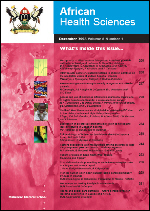
|
African Health Sciences
Makerere University Medical School
ISSN: 1680-6905
EISSN: 1680-6905
Vol. 19, No. 3, 2019, pp. 2302-2312
|
 Bioline Code: hs19117
Bioline Code: hs19117
Full paper language: English
Document type: Research Article
Document available free of charge
|
|
|
African Health Sciences, Vol. 19, No. 3, 2019, pp. 2302-2312
| en |
Behavioral factors contributing to the transmission of HIV and AIDS amongst young women of Mbabane in Swaziland
Belle, Johanes A & Gamedze, Nokuthula N
Abstract
Background: HIV and AIDS remains a pandemic that has greatly affected many regions and countries in the world. Africa is the hardest hit region by tthis disease while southern Africa appears to be the melting pot for HIV and AIDS. The HIV and AIDS pandemic remains the greatest sustainable human development and public health challenge for Swaziland. Swaziland is the world’s worst affected country with the youth the most vulnerable group to HIV and AIDS due to many factors.
Objectives:’Methods: This study investigated the behavioral factors that contributed to the transmission of HIV and AIDS among female youth of Mbabane in Swaziland and to suggest measures that could encourage positive female youth behavior change in order to mitigate the spread and impacts of the pandemic. The study used a qualitative research approach in order to gain an in-depth experience of female youths in Mabane. Data were collected using a questionnaire, which were distributed to 210 randomly sampled females aged 16 to 24 years in Mbabane and who attended Mbabane Public Health Unit. The Behavior Change Communication (BCC) theoretical framework was usedin order to contextualize the study.
Results: Most respondents were female-single youth (64%), almost half (45%) had a high school education and most were unemployed (57%) with little or no source of income. The majority (88%) were sexually active and the main sources of HIV/AIDS transmission was through sex. For many (52%) health facilities were their main source of HIV and AIDS information. The majority (97%) were knowledgeable about HIV and AIDS, but casual sex, inconsistent condom usage and early sexual debut among others were still prevalent indicating resistance to behavior change.
Conclusion: The findings indicated that though the majority of the respondents had knowledge of HIV and AIDS, positive behavior change remained a challenge. Most respondents (88%) had one sexual partner with 38% reporting condom use during their last sexual encounter. HIV/AIDS awareness was widespread. However, there were still characteristics of resistance to behavior change, because there was evidence of underestimation of HIV risk through engagement in behavior, which contributed to HIV infection and spread.Behavioral change measures using the BCC model is proposed.
Keywords
BCC Model; behavior change; HIV; AIDS; youth; Swaziland.
|
| |
© Copyright 2019 - Belle et al.
|
|
